This four-image montage comprises images taken of Comet 67P/Churyumov-Gerasimenko on 20 November, from a distance of 30.5 km from the centre of the comet. The image resolution is 2.59 m/pixel, so each 1024 x 1024 frame measures 2.66 km across. The four images making up the montage are provided at the end of the post.
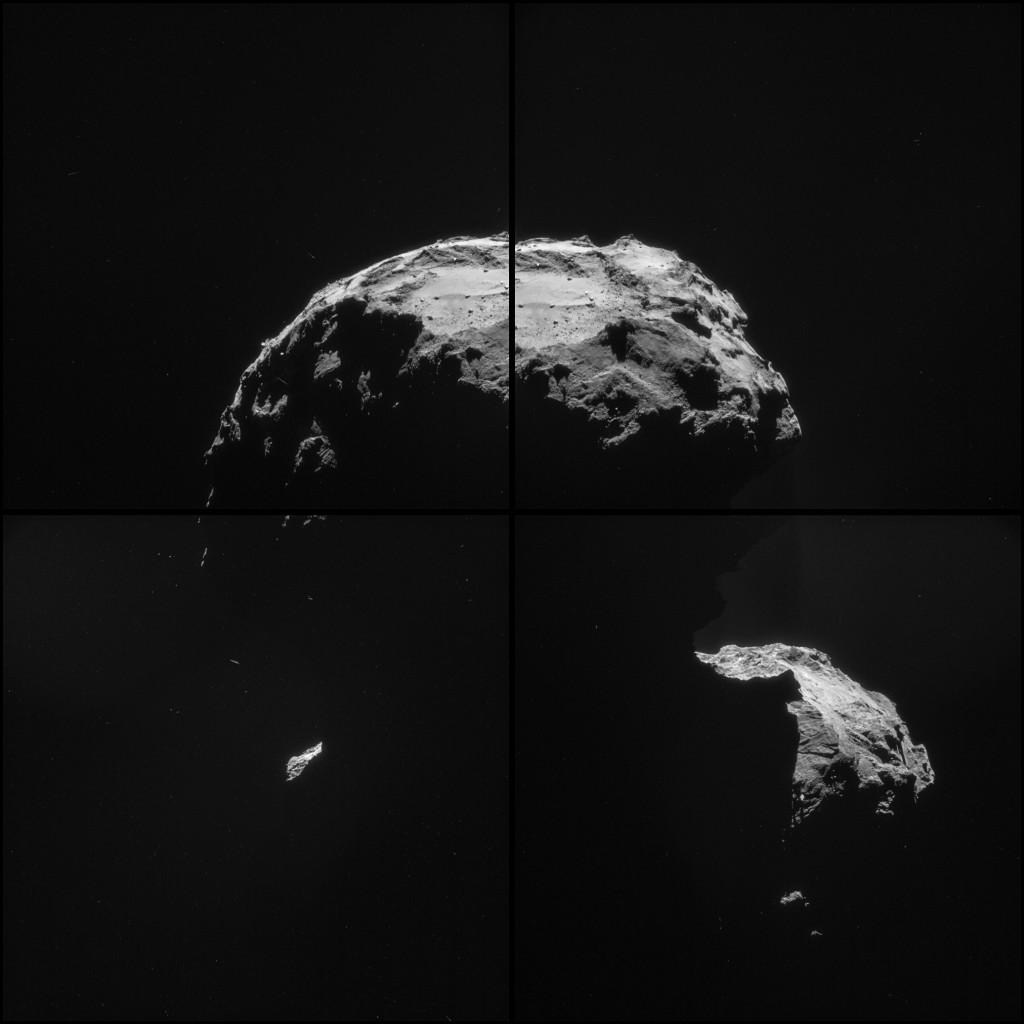
Four image NAVCAM montage comprising images of Comet 67P/C-G taken on 20 November. Credits: ESA/Rosetta/NAVCAM – CC BY-SA IGO 3.0
The montage has been lightly processed, pushing the contrast a little to bring out some of the shadowed regions. There appear to be some background artefacts due to internal scattering or ghosting that shouldn’t necessarily be interpreted as real coma features. The high dynamic range in these images may cause problems in some mosaicking tools. Note that the processing of the raw frames has been updated to eliminate a false grey level offset.
The image montage focuses on the large depression on the smaller of the comet’s two lobes, and includes the region that is the focus of the search efforts for lander Philae. Using the CONSERT experiment that is onboard both Rosetta and Philae, the search is focused on a region close to the rim of the depression (see our previous blog post Homing in on Philae’s final landing site to see the region in question). Higher resolution imaging with the OSIRIS camera is expected to identify the final location of the lander.
The montage shown here also presents part of the ‘dark’ unseen side of the comet, currently cast in shadow because it is facing away from the Sun. As the comet gets closer to and moves around the Sun along its orbit next year (perihelion is on 13 August 2015) then this side will become fully illuminated.

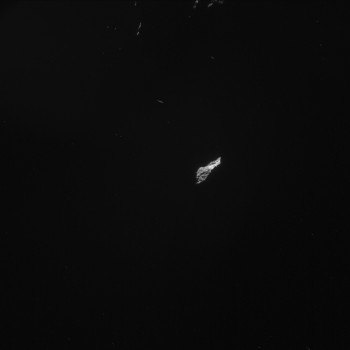
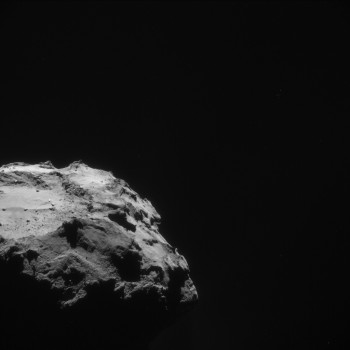
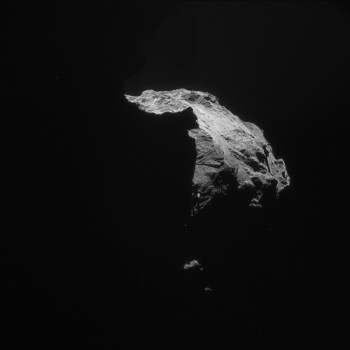
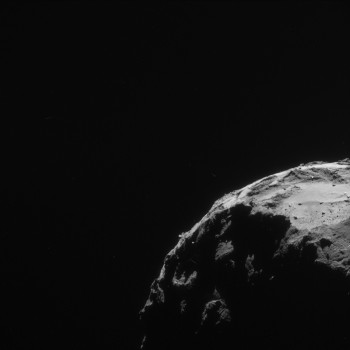








Discussion: 72 comments
Not ESA-related, but the AGU is having a December and actual color images of 67P are on the agenda:
The Conference:
https://agu.confex.com/agu/fm14/meetingapp.cgi#Paper/22395
The sample image:
https://agu.confex.com/data/abstract/agu/fm14/5/9/Paper_22395_abstract_18425_0.png
Now onto today’s Navcams…
–Bill
Thanks Bill. So its more orange than dark red as I was expecting. The exposed, dust free areas are a darker red, from Tholin compounds, the dust/ice layer dilutes the colour to a pink/orange colour. The other noticeable features are a second large crater on the back of the head and the “mountain ridge” that runs down the back of the head.
The southern hemisphere is noticeably devoid of dust and has a lot less vertical variation in the terrain indicating a lot more erosion and sublimation activity to remove the surface dust. The inevitable conclusion is that this is the result of greater exposure to thermal radiation at Perihelion when summer is in the Southern hemisphere. It is also probably why the lobes are shorter on this southern half of the comet. The formation mechanism of the neck in the Northern hemisphere becomes even more intriguing, the presence of so much dust suggests this feature is the result of processes that occurred well before 67P’s orbit came closer to the sun.
This is an enhancement of the image in the abstract. It has been processed to eliminate the masking color of the overlying dust and emphasize the variations of the underlying features. In this way, the spectral signature of the surface materials of the comet can be evaluated.
Image Source: ESA/Rosetta/OSIRIS/DLR
https://univ.smugmug.com/Rosetta-Philae-Mission/Rosetta-Geomorphology/i-hWgq45N/0/L/Paper_22395_abstract_18425_0–enh1-L.png
–Bill
May we finally see pictures from Philae after its touchdown in the first spot? Don’t say that 20 year mission planners did not predict something might go wrong and the thing could roll over. It was the only chance to take perfect panorama. In the very first half of second it touched down and hit the ground…
Hi Emily and H. NAVCAM Team. 8X Zooming and no headache 🙂
I was inspired by the sound captured by the Rosetta spacecraft of Comet 67P, so I wrote a cosmic-love song and incorporated the comet’s song. Enjoy! https://soundcloud.com/brettaustinmusic/celestial-lover
BA this is really a beautiful creative song. Really lovely!
The particle-sphere is becoming insidious.
Remember those fizzy breeze over a cold soda glass? 🙂
A close encounter with the lens at the top left quadrant. The object halved the distance in the 6s? exposure.
Which object? I spot a couple ‘shooting stars’, but how do you judge distance change?
Hi Jacob. Looking at the small lobe as a clock, at 10 o’clock approaching the head’s horizon from the center. Describing it as a line with wobbling thickness. one extreme being double than the other. one extreme more marked than the other. Just remarked by the shadow at the left of the cliff.
Pixel 559,761 of
https://blogs.esa.int/rosetta/files/2014/11/ESA_Rosetta_NAVCAM_141120_montage.jpeg
Thanks for this Emily. This image gives us a view of the blue area indicated by the CONSERT data. The different viewpoint makes it difficult to match the shape to the terrain, but within the approximate region there appear to be a number of shadowed spots that could be Philae’s hiding place. Given the scale Philae would barely fill a pixel so finding her seems improbable.
I thought I would check out my best guess anyway at the best magnification I could and I might just have found Philae. I won’t say for sure because it is not an unbiased opinion, but others can have a look and offer their thoughts.
https://www.flickr.com/photos/124013840@N06/15868441451/
I managed to work out how to publish the close up image I got yesterday. I’m still not convinced and I’m sure others won’t be either, but hopefully those at ESA with better tools and the original data might be able to do better.
https://www.flickr.com/photos/124013840@N06/15690427237/in/photostream/
The triangle of light spots at the top of the crevice might be where Philae touched down the second time. The feet squashing the dust flat so the icy subsurface shows through more. Clutching at straws again, but the fall would be about 10 to 15 metres and would take about 7 minutes at 3cm/s.
Hi Robin. Consider it a candidate.
this time, the stretch is really too long. We are missing so much information: time of the navcam picture vs landing time (that we have), hence shadows on the comet, the rotation axes for the comet (we have the 12.4 hours for the principal axis, what about the period and amplitude of other axes if relevant?), …
Working on this subject would be very exciting, but is really reserved to the happy few who got the privilege of working for years on the topic (while Rosetta was merely the name of a stone, not an icy bouncy duck explorer) and they do actually deserve the pleasure of doing the job (better than I could, certainly).
BTW, I understood the 60W story -I think-: the battery needs about 60 Wh before allowing more than self-survival. Remains to understand (as before) how much power is consumed by the system to heat up the battery from the ~6 W delivered by the Solar panel. At ~3h/(Earth)day of illumination, it could range from 25 days to 70-100 days (with 20% resp. 80% power used for survival).
Hi JP. Ah the crucial error of units, 60Wh not 60W. So earliest we might expect to hear from Philae is about March time next year then. Hopefully she will be found before then, not much sign after 2 weeks of looking.
Hi JP. Maybe I’m wrong, but it’s hard-wired. All/Most? of the energy is going to battery heaters. When reached 0ºC it will open the charging circuit too. If certain Voltage achieved then it will try to boot Rosseta link. If fail then it will try again 30min later.
My building blocks…
Jenga
Legos?
Beautiful collimating in the bright facet of bottom right quadrant 🙂
Could you collect your single.sentence posts to one,
so I could easier skip over !
@Erwin, Logan contribute philosopy, poetry and gentleness to this blog… And some keen observations to boot.
Here’s the ‘s’ and the ‘h”
And the rating? 🙂
Hi Erwin. I’m socially challenged. Dividing increases chance of at least some of my lines being published 😉
@logan Imagine everybody would do that.
@Jacob nielsen That much to “gentleness”.
Your best post yet, Logan. Love it!
Look for the face on the right edge of the big lobe sticking its tongue out at us, defying us to unlock 67P’s secrets.
https://blogs.esa.int/rosetta/files/2014/11/ESA_Rosetta_NAVCAM_141120_D.jpg
A Greek daemon, Robin. [Maybe just a faun mocking at us. Hope there some wine around there].
In keeping with the 67P Egyptian theme, maybe comets are where the ancient Egyptian Pharaohs go in the after life. The headdress does sort of give that impression. It could be Khufu himself just popped out from his pyramid at Cheops.
Philae is just here, behind this big rock !
https://postimg.org/image/rvvgllmbb/
Hi ARNAUD. CONCERT should be re-run for every candidate.
Hey, little philae, where ar you…..?
Greetings,, I don’t want to jump in here prematurely,
even so thanks for the images.
and if you haven’t already elimated a geometrically shaped bright sopt on the right side of the neck at shadow’s edge,, scope this out,,, what is this:
para-az.com/comet67p-cg/hang-on.jpg ?
I Know it’s pretty speculative but I wonder if Philae finally landed near candidate area B, over the right side of the depression (image C , Top right in the image composition above. I’ve sketched it at
https://4.bp.blogspot.com/-HdqRBYjoUzs/VHORjlVUhtI/AAAAAAAABWc/dtBO5EuoO1A/s1600/Philae%2BFound!.001.jpg
More resolution is needed -in this image Philae would be smaller than 1 single pixel (!)- and obviously much solid evidence.
Absolutely impressive Job ESA!
It looks very promising, but I think it is not Philae. It lies outside the area determined by CONSERT measurements. The slope of terrain does not match – it is almost in right angle to the direction in which Philae supposedly landed. The terrain is rather flat at that point while Philae’s photos suggested it is in some kind of a valley or crack. It casts very long shadow and looks very big to me, way bigger than Philae is. And I found similarly bright object at corresponding place in photos preceding the landing.
Absolutely stunning !
This image makes me think to the one, previously published, that I used in my “video tribute” to Rosetta & Philae (at 0′ 51″) :
https://www.youtube.com/watch?v=B81jrqaNOYs&list=UUJBLJ2ovXQ-_vTu0JOrZIww
GREAT JOB ESA !
🙂
And here is a tweaked version of the 20 November Navcam Montage showing dust jet activity:
https://univ.smugmug.com/Rosetta-Philae-Missionh/Rosetta-Dust-Jets/i-DqB9pPD/0/L/ESA_Rosetta_NAVCAM_141120_montage–enh1-L.png
Source: ESA/Rosetta
–Bill
Thanks Bill, the best work! Every day more convinced that lobes have different potential.
Thank you for the images Bill. Just a little confused how dust of any size/quantity has managed to ‘leave’ the comet at this stage.
Please advise.
Thank you.
Wow, I’ve spotted Philae. And it only took 4 glasses of wine!
That’s energy efficiency, Bruce 😉
Stop looking! Someone already found Philae in the last Navcam. Proof at this link.
https://imgur.com/a/jbQuD
Please CONCERT team, re-run from this coordinates. Just as an exercise.
Is Mattias Malmer’s depth interpretation on twitter #CometLanding consistent with this view?
Speaking of Matthias, he has spiced up the CIVAS landing image. Its brilliant.
https://mattias.malmer.nu/2014/11/civa-depth-cues/comet_depth_cues/
I think that ESA public relations could get a boost if they release a high quality images from the possible landing site and launch a public contest to find Philae, this way more eyes are better at spotting it and at the same time catch public attention.
Too bad my two best candidates for Philae from these photos both lie safely out of the zone where Philae should be according to the CONSERT data analysis.
But as long as Philae supposedly landed “vertical”, i.e. in a plane parallel to the original landing spot – which is behind horizon in these photos – we’re viewing it edge-on here or it could be hidden behind a boulder from this perspective.
https://radumate.tumblr.com/post/103566275248/comet-67p-churyumov-gerasimenko
TO ESA PERSONNELL PLEASE, CREATE A PHILAE SEARCH CONTEST!!!!!!!
MAKE PUBLIC PARTICIPATION A HAPPENING FOR THE SEARCH OF PHILAE
You will not be able to spot Philae in these images, since the area comprised in each single pixel is about 6.7 times larger than the area of Philae.
No science, but a couple of fun pictures.
This is a set of x-eyed stereo pairs made from the B and C frames of the montage.
One is a wide view across the Equatorial Crater, good if you have a Stereo Viewer:
https://univ.smugmug.com/Rosetta-Philae-Mission/Philae/i-gG29PdN/0/L/ESA_Rosetta_NAVCAM_141120_B-C–X-eye_stereo-L.png
A cropped version for bare-eyed viewing, the area to the South of the crater, where Philae might be hiding:
https://univ.smugmug.com/Rosetta-Philae-Mission/Philae/i-gG29PdN/0/L/ESA_Rosetta_NAVCAM_141120_B-C–X-eye_stereo–crop1-L.png
Another cropped version to the north of the crater, the Agilkia landing site is at the top near the horizon:
https://univ.smugmug.com/Rosetta-Philae-Mission/Philae/i-gG29PdN/0/L/ESA_Rosetta_NAVCAM_141120_B-C–X-eye_stereo–crop2-L.png
Enjoy!
–Bill
Fooey. I got the two cropped web addresses wrong.
Here they all are again:
One is a wide view across the Equatorial Crater, good if you have a Stereo Viewer:
https://univ.smugmug.com/Rosetta-Philae-Mission/Philae/i-gG29PdN/0/L/ESA_Rosetta_NAVCAM_141120_B-C–X-eye_stereo-L.png
A cropped version for bare-eyed viewing, the area to the South of the crater, where Philae might be hiding:
https://univ.smugmug.com/Rosetta-Philae-Mission/Philae/i-6rp2CXX/0/L/ESA_Rosetta_NAVCAM_141120_B-C–X-eye_stereo–crop1-L.png
Another cropped version to the north of the crater, the Agilkia landing site is at the top near the horizon:
https://univ.smugmug.com/Rosetta-Philae-Mission/Philae/i-M7KGHjN/0/L/ESA_Rosetta_NAVCAM_141120_B-C–X-eye_stereo–crop2-L.png
–Bill
No one can deny the success of the Rosetta Spacecraft; it has performed every task to perfection. The imagery captured of the comet G67’s surface is unsurpassed. ESA should be excessively proud of Rosetta’s performance as well as its great contribution to the global knowledge of the Comet Astronomy.
With this said, I think the ESA has been overly self-congratulatory in regards to the performance of the Philae Lander. I realize this was not done as an act of dishonesty; rather it was a very human reaction by persons that are emotionally connected to the Philae Lander Project. In such situations objectivity has little chance of functioning. Early on one ESA quote proclaimed “…the [Philae] lander achieved the first-ever controlled touchdown on a comet nucleus.”, but the facts was that the lander suffered two major failures to its surface landing system. The first happening before the lander was even released from Rosetta, the cold gas jet thrusters that fire upon contact with the comet’s surface to help secure the lander failed to prime and start-up. This left only the Harpoon system to secure the lander, and then once this had failed to operate as well, there was nothing left to keep Philae in-place where it had touched down, rather away it went on an uncontrolled two and half hour bounce across the comet’s surface. At the exact moment when the Control Center members were ecstatically celebrating the success of their lander’s “controlled touchdown”, Philae was in the midst of its now famous double-bounce maneuver that resembled more of a “crash” and less of the publicized “controlled” landing.
ESA defined the Philae Probe’s mission very specifically as the following : …1.) to land successfully on the surface of the comet, 2.) attach itself, and 3.) transmit data from the surface about the comet’s composition. You can argue the “success” of the landing in both directions, but #2 of the mission list was a definite failure. Now due to the lander’s “lack of attachment”, many of the scientific tests that were planned for determining the comet’s composition are now in jeopardy. To make matters worse Philae came to rest at the base of a rock shelf in the shade of a cliff. Now Philae’s exposure to the Sun has been significantly reduced along with its ability to recharge its batteries from its solar cells. At the moment the lander continues to be in a state of hibernation, which is a nice way of saying Shut-Down, until the batteries can be significantly charged.
Well now, this gives Brad a new goal in life: to propose, design and implement a comet lander mission that is 100%.
😉
Holler back when you’ve done that.
🙂
–Bill
Hi Brad. Maybe you are right about a little excess on the PR. Would tend to agree with you if Comet Landings where space routines by now, as is ‘anchoring’ to ISS. To my old memory of first time failures, Philae is a success in full right. If goes ‘live’ again, then it will be an ‘historic’ success, as Rosetta is by now.
We can probably rule out the location i’ve identified as
a candidate since any visibility of jet activity at the neck
may be beyond reasonable expectations.. There is a significant obstruction in the way toward the intended
landing lobe..
My hunch is that the Rosetta/Philae science teams, with all the firepower they have at their disposal, have already precisely located Philae, from their considerable (but largely undisclosed) battery of NAVCAM and OSIRIS images on the one hand and from the totally undisclosed CONSERT data on the other (let alone all the equally undisclosed data from other instruments).
There is absolutely no reason for them to be more forthcoming with this information than with all the rest. They clearly announced well in advance their policy of not disclosing all information immediately, so if my hunch is correct, we would have nothing to be surprised, or to complain, about
And if my hunch is correct, they are presumably sitting on the information while trying to work out a way of how to present the CONSERT data on the internal composition of the nucleus in such a way as to be able to announce that it is “not inconsistent with” the standard “dirty snowball”model.
Your ‘hunch….presumably’ amounts to libel.
Just *in case* they present data which does not agree with your pet theory, you accuse the team of preparing an utterly unprofessional and dishonest act.
I suggest you provide evidence for that or withdraw the comment.
You may presume whatever you wish, Prof. There is no evidence to provide, since it’s a *hunch*. There is absolutely no question of libel and absolutely no reason to withdraw the comment. Time will tell, once the location of Philae is finally disclosed, whether my hunch was right or not.
As to the accusations of dishonesty and unprofessional conduct you allege me to be making, I leave you with the entire responsibility for your allegations. I have repeatedly stated on this forum my absolute admiration for the various teams of Rosetta mission engineers who designed the orbiter and lander hardware (and software) and then delivered them precisely and punctually where they were supposed to go. I consider it the most extraordinary feat in space exploration since the Apollo Moon landings.
My doubts concern only the role of the *astrophysicists* whose job it is now to interpret the data obtained.
I assume you know as well as I do how academic science actually works, via such mechanisms as the “peer-review process” which, *whatever the branch of science concerned*, is demonstrably designed to maintain intact the existing body of supposed *knowledge*, primarily for understandable corporation-related (and not necessarily science-related) reasons. The main scientific findings of the Rosetta mission will, as has been announced, be communicated by papers published in scientific journals, having undergone the peer-review process.
You would thus be seen to be rather disingenuous if you were to claim that the astrophysicists involved in the Rosetta mission were necessarily a complete exception to this rule of broadly seeking to maintain the status quo of currently constituted “knowledge”.
The most famous recent example of scandalous “scientific” corporatism concerns the “Climategate” affair in 2009, revealed (as you probably know) when a whistle-blower released thousands of emails exchanged privately between the leading and most influential “climate-scientists” engaged in the promotion of the theory of “global warming” (since curiously renamed “climate-change” – I wonder why?), under the auspices of the UN’s IPCC. The emails unequivocally proved collusion to suppress “discordant” data tending to invalidate the “global warming” theory (Trenberth’s famous “Hide the decline” expression), to actively exclude dissenters from all positions of influence and to take complete control of the peer-review process by exerting suitable pressure on the editors of all the relevant scientific journals. Sure, the disciplinary proceedings were a complete whitewash, but so what? The evidence of scientific malpractice is there for all to see.
There are numerous other less well-known cases which I could cite, but the “Climategate” scandal says it all.
I’m not saying at all that the Rosetta astrophysicists will necessarily seek to suppress or spin any inconvenient data they have acquired as the leading figures of the climate-science Establishment did (and are still doing – see the just-published IPCC Fifth Assessment Report which makes virtually no mention of the henceforth 18-year-long “Pause” in so-called global warming), but simply that the temptation is necessarily there, for the reasons I have outlined.
Thomas, just look up the definition of libel. You can call it a hunch, whatever you like. If you *publish* – and the net is publishing – a defamatory statement, it’s libel. Claiming someone is preparing a dishonest, unprofessional act is clearly defamatory.
They would of course not bother to act on it, but throwing such completely unsupported allegations around weakens your arguments.
The ‘drawings’ of ‘core’ material are so boldly seen at bottom center of top-left quadrant.
Pixel 665,924 of 20nov mosaic.
Should we call them ‘hieroglyphs’?
More at center of top-right quadrant. Nov20 mosaic.
At perihelion it will look like the temple of the ‘hieroglyphs’.
That structure at extreme right of big lobe shows something like volcanic sketches.
Dirty ice extrusion at 12 o’clock near the horizon of nov20 mosaic.
If you make luminosity statistics from the photo library, then you could see that -more than ‘curvatures’- 67P has ‘facets’.
If 67P surface ‘faceted’ then I expect the inside of 67P following, too.